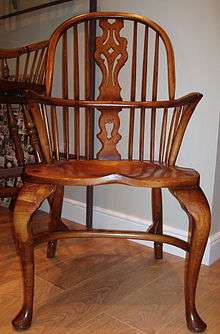Club foot (furniture)

A Windsor Georgian Double Bow chair with pad-footed cabriole legs at the front. The back legs are plain.
A club foot is a type of rounded foot for a piece of furniture, such as the end of a chair leg.[1][2] It is also known by the alternative names pad foot[3][4][5] and Dutch foot,[4][5] the latter sometimes corrupted into duck foot.[6]
Such feet are rounded flat pads or disks at the end of furniture legs. Pad feet were regularly used on cabriole legs during the 18th century.[7][8] They can be found on tables, chairs, and some early sofas.
Pad feet were first seen in the French and Italian Renaissance periods and have been widely used ever since. Pad feet can still be seen on some classical furniture.
See also
References
- ↑ John Gloag (2009). "club foot". A Short Dictionary of Furniture. READ BOOKS. p. 190. ISBN 978-1-4446-2040-5.
- ↑ John Gloag (2009). "foot". A Short Dictionary of Furniture. READ BOOKS. p. 259. ISBN 978-1-4446-2040-5.
- ↑ John Gloag (2009). "pad foot". A Short Dictionary of Furniture. READ BOOKS. p. 348. ISBN 978-1-4446-2040-5.
- 1 2 Ethel H. Bjerkoe (1997). "Dutch foot". The Cabinetmakers of America. Schiffer Pub Ltd. pp. 266, 268.
- 1 2 Carl William Drepperd (1980). The primer of American antiques. Gramercy Pub. Co. p. 221. ISBN 9780517309926.
- ↑ L. G. G. Ramsey (1961). "Duck foot". The concise encyclopedia of antiques. 1. Hawthorn Books. p. 61.
- ↑ Bird, Lonnie (2003). Taunton's Complete Illustrated Guide to Period Furniture Details. Taunton Press. p. 44. ISBN 1-56158-590-4.
The pad foot was the most common form of foot used on 18th-century cabriole legs
- ↑ It used the hoof foot in many places, and also the pad foot (most popular in present-day cabriole legs) ... Sparkes, Ivan G. (1981). English Windsor Chairs. Shire publications. p. 7. ISBN 0-85263-562-1.
Further reading
- Lonnie Bird (2003). "Feet". Taunton's Complete Illustrated Guide to Period Furniture Details. Taunton Press. pp. 42 et seq. ISBN 978-1-56158-590-8.
- Joseph Aronson (1967). "pad foot". The new encyclopedia of furniture. Crown Publishers.
This article is issued from Wikipedia - version of the 5/25/2016. The text is available under the Creative Commons Attribution/Share Alike but additional terms may apply for the media files.